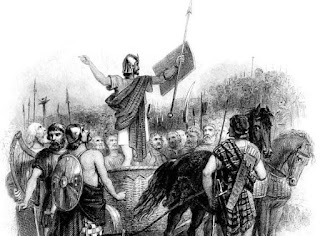Inchcolm Antiphoner
SONGS ACROSS TIME
Inchcolm Abbey, where the Antiphoner (a musical manuscript) originated.
Scotland's Inchcolm Antiphoner is one of the most important yet neglected manuscripts in the history of early European music.
It contains the only definitive remnants of the music of the Celtic Church, which was responsible for Christianising large areas of Europe. And it includes music probably composed in the 7th century, whose melodies are as unique as the organisation and practices of this ancient Church.
The manuscript also shows that from an early date, Scotland's music has had a distinctive identity. It was written down, probably in the 13th century, on the island of Inchcolm, which lies in the Firth of Forth and can be clearly seen from Edinburgh.
The music, known as plainchant, is the unaccompanied vocal music of the early Church, and it formed part of the soundtrack of the arrival of Christianity in Scotland.
Plainchant was sung tirelessly by monks as a means of providing their devotion with a grace and beauty that gloried God and the saints, and no doubt cheered an otherwise pretty spartan existence.
Thanks to the Inchcolm Antiphoner, we can still hear the monks' haunting melodies today.
In modern performance, each note in the composition is given roughly the value of a quaver, although nobody knows exactly how the plainchant was sung. This is because in the manuscript the words to the chants are strung out along the staves with no sign as to the length of each.
By the time of its creation, the abbey might have been expected to be devoted to Gregorian chant-a type of chant which honoured St Gregory—whose use had been decreed elsewhere by Scottish Benedictine and musical theorist Aaron Scotus in the 11th Century.
But among other things, the Inchcolm Antiphoner contains plainchant for a service in memory of the distant St Columba of lona.
This Columban connection dates back to the foundation of the abbey by King Alexander I, an account of which is given by Medieval chronicler Walter Bower-who was. himself an abbot of Inchcolm.
When crossing the Forth at Queensferry in the year 1123, Alexander was forced to seek refuge on the island of ' Aemonia. ' The king and his retinue survived thanks to the support of an island hermit who was a dedicated follower of St Columba. Alexander vowed he would give thanks by founding a monastery on the island affording shelter to sailors and the shipwrecked, dedicated to Columba. This he did, and the island then became Inchcolm, or Columba's island.
Many chants were shared commonly throughout Europe, and parts of the manuscript draw on widely-shared material, But all the texts referring to Columba in the Inchcolm manuscript are unique, and for many of these the music is also unique. They may come from a long-lost 7th century manuscript composed and housed on lona.
Among the unique chants are settings of texts which show an intimate connection with carly Celtic Latin, and a close relationship with Adomnan's Life of Columba written in the late 7th century. If a relationship between texts such as Adomnan's 'Life' and the structure of the music can be found, we will know with certainty they were conceived at the same time.
Leading opinion holds that the mention of Rome in one of the unique chants is strong evidence of the composition dating from around Adomnan's time
Iona reluctantly brought its church practices into line with Rome not long after Adomnán's death. The word "Romani is set to the lowest note in the chant,suggesting a negative association. But the emotive words "you sweeten bitter apples' see the music sweep to its highest note. The 7th century conversion to Roman practices may have been the bitter apple referred to here, sweetened by the monk's continued devotion to their founding father, Columba.
The Inchcolm Antiphoner is a beautiful testament to the importance of ancient music to Scotland's rich cultural tapestry, while at the same time showing the Scots to have been at the heart of European musical tradition. It is truly wonderful. It allows us to imagine that we are standing among Columban monks from 1,300 years ago.










Comments
Post a Comment